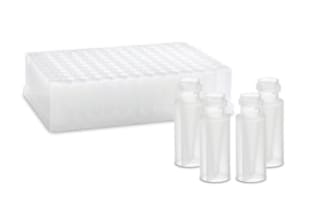QuanRecovery HPS Vials & Plates
Reduce sample losses due to non-specific binding (NSB)
Successfully quantitating proteins and peptides with LC–MS is often more challenging than doing so for small molecules. Their large and complex structure requires a different approach to LC–MS method development and may also cause other unique problems like nonspecific adsorption (or nonspecific binding). Proteins and peptides in solution tend to stick to the surfaces they encounter.
Autosampler-ready QuanRecovery Vials and Plates with MaxPeak High Performance Surfaces (HPS) are designed to enable scientists like you to meet recovery, sensitivity and reproducibility challenges in LC-MS peptide and protein quantification. By reducing sample losses from non-specific binding (NSB) and ionic interactions, QuanRecovery Vials and Plates provide your lab greater confidence in analytical results and fewer long-term assay repeatability problems.
Specifications
Overview
- For large molecule LC-MS bioanalysts who need the ultimate sensitivity, reproducibility and sample stability over multiple analyses.
- Improve detection limits and analysis reproducibility for peptide and protein quantification with these low adsorption plates and vials.
- Designed for LC-MS analysis in autosampler ready formats with low residual volumes in 700 µL 96-well plate and 300 µL sample vial formats.
- Increase analyte recovery, sensitivity and reproducibility by minimizing analyte/surface interactions that can lead to sample losses with MaxPeak High Performance Surfaces (HPS).
- Suitable for workflows with ACQUITY Premier Systems and Columns.
Recommended Use: To minimize sample losses due to non-specific binding (NSB) and ionic interactions.
Features Header
Improved LC-MS analysis of peptides and proteins
It can be difficult to predict peptide losses due to non-specific binding and ionic interactions, as losses can be dependent on many characteristics, including pI and hydrophobicity. Demonstrated here are the recovery of four different peptides. The recovery of desmopressin is not affected by the sample container, while glucagon, insulin, and melittin suffer varying losses due to non-specific binding and ionic interactions in the glass and standard polypropylene containers.
Only QuanRecovery Vials and Plates with MaxPeak HPS protect these peptides from loss, enabling you to achieve higher recovery and improved repeatability.
Enhanced recovery and sensitivity at high and low sample concentrations
Biomolecule sample losses are a problem at low concentrations. However, non-specific binding and ionic interactions can also cause losses at higher concentrations. Such losses not only negatively impact the assay sensitivity, they also compromise the reproducibility, precision, and accuracy of the analysis. QuanRecovery Vials and Plates with MaxPeak HPS protect your sample, ensuring improved analytical results.
